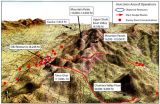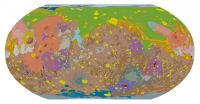(Press-News.org) Scientists who study patterns in survey results might be dealing with data on language rather than what they're really after -- attitudes -- according to an international study involving the University of Colorado Boulder.
The study, published in the journal PLOS ONE, found that people naturally responded to surveys by selecting answer options that were similar in language to each other as they navigated from one question to another, even when the similarities were subtle.
For the study, researchers looked specifically at surveys on organizational behavior, such as leadership, motivation and job satisfaction.
"The findings suggest many survey participants likely fit the first question into their language understanding and, when they get to the next question, move in their language network to figure out how close it is to the previous question in order to respond," said Kai Larsen, information scientist and associate professor of management and entrepreneurship at CU-Boulder's Leeds School of Business. Larsen is a co-author of the paper.
The findings also raise questions about the way scientists design and analyze surveys, inadvertently focusing attention on the shared language understanding of respondents, said Larsen.
"The methods used for surveys are making it difficult to get at what's unique about an organization rather than what's embedded in general language," he said.
Often when social scientists conduct surveys with human participants, they look at more than just average scoring. In the results they detect -- and measure -- patterns. They quantify, for example, how much a popular answer to one question likely leads to a popular answer on another question to find common relationships.
The measurements help form statistics like, "people who highly rate their manager's leadership style are more likely to stay longer at their jobs."
In the case of the current study, researchers measured the degree of similarity in survey language instead of human response patterns. When they compared the measurements to measurements of human response patterns, the two sets of numbers were nearly identical, indicating the measurement of language similarities and people's selection of survey answer options were practically the same thing.
For the study, the researchers applied two algorithms, or complex computer-operated calculations -- each using radically different approaches -- to measure sentence similarities.
The first algorithm involved about 100,000 newspaper articles to evaluate word similarities used within. The second algorithm relied on an online database created by linguists that shows the relationship between tens of thousands of words.
The surveys used in the study were already published and taken by anonymous respondents in a variety of fields from finance and government to engineering and the military. The respondents also included business students.
One type of survey that was not found to be language-based in the study was personality testing.
Other authors of the paper included lead investigator Jan Ketil Arnulf, associate professor of leadership and organizational behavior at BI Norwegian Business School; Øyvind Lund Martinsen, professor of leadership and organizational behavior at BI; and Chih How Bong, senior lecturer in computer science and informational technology at the University of Malaysia at Sarawak.
The results of the findings may point to ways of improving research methods.
"With surveys, we may be able to help researchers focus on respondents who aren't answering in a language-based way," said Larsen. "Because they are revealing actual and unexpected attitudes, they may be the ones you want to pay attention to."
The study also highlights the growing prowess of data science.
"Semantic algorithms are becoming new tools for the social sciences and are broadening perspectives on survey responses that other longtime theories cannot explain," said Arnulf. "This represents a study of how the relatively young data sciences can address problems not approachable with traditional methods."
INFORMATION:
To see the complete study visit http://www.plosone.org/article/info%3Adoi%2F10.1371%2Fjournal.pone.0106361.
Surveys may assess language more than attitudes, says study involving CU-Boulder
2014-09-23
ELSE PRESS RELEASES FROM THIS DATE:
Researchers reveal new rock formation in Colorado
2014-09-23
Boulder, Colo., USA - An astonishing new rock formation has been revealed in the Colorado Rockies, and it exists in a deeply perplexing relationship with older rocks. Named the Tava sandstone, this sedimentary rock forms intrusions within the ancient granites and gneisses that form the backbone of the Front Range. The relationship is fascinating because it is backward: ordinarily, it is igneous rocks such as granite that would that intrude into sedimentary rocks.
According to authors Christine Smith Siddoway and George E. Gehrels, to find sandstone injected into granite ...
Note to young men: Fat doesn't pay
2014-09-23
Men who are already obese as teenagers could grow up to earn up to 18 percent less than their peers of normal weight. So says Petter Lundborg of Lund University, Paul Nystedt of Jönköping University and Dan-olof Rooth of Linneas University and Lund University, all in Sweden. The team compared extensive information from Sweden, the United Kingdom and the United States, and the results are published in Springer's journal Demography.
The researchers analyzed large-scale data of 145,193 Swedish-born brothers who enlisted in the Swedish National Service for mandatory military ...
Immune system is key ally in cyberwar against cancer
2014-09-23
Research by Rice University scientists who are fighting a cyberwar against cancer finds that the immune system may be a clinician's most powerful ally.
"Recent research has found that cancer is already adept at using cyberwarfare against the immune system, and we studied the interplay between cancer and the immune system to see how we might turn the tables on cancer," said Rice University's Eshel Ben-Jacob, co-author of a new study this week in the Early Edition of the Proceedings of the National Academy of Sciences.
Ben-Jacob and colleagues at Rice's Center for Theoretical ...
UTSA microbiologists discover regulatory thermometer that controls cholera
2014-09-23
Karl Klose, professor of biology and a researcher in UTSA's South Texas Center for Emerging Infectious Diseases, has teamed up with researchers at Ruhr University in Bochum, Germany to understand how humans get infected with cholera, Their findings were released this week in an article published by the Proceedings of the National Academy of Sciences.
Cholera is an acute infection caused by ingestion of food or water that is contaminated with the bacterium Vibrio cholerae. An estimated three to five million cases are reported annually and 100,000-120,000 people die from ...
'Space bubbles' may have aided enemy in fatal Afghan battle
2014-09-23
WASHINGTON, DC—In the early morning hours of March 4, 2002, military officers in Bagram, Afghanistan desperately radioed a Chinook helicopter headed for the snowcapped peak of Takur Ghar. On board were 21 men, deployed to rescue a team of Navy SEALS pinned down on the ridge dividing the Upper and Lower Shahikot valley. The message was urgent: Do not land on the peak. The mountaintop was under enemy control.
The rescue team never got the message. Just after daybreak, the Chinook crash-landed on the peak under heavy enemy fire and three men were killed in the ensuing firefight.
A ...
This week from AGU: New geologic map of Mars, storm surge in Florida
2014-09-23
From this week's Eos: The New Geologic Map of Mars: Guiding Research and Education
Currently, five spacecraft are investigating Mars, and a swarm of new missions to the Red Planet either have been launched or are in development. They are designed to probe the surface, subsurface, and atmosphere with a host of scientific instruments. Where will they make new discoveries? Clues to where they should focus investigations can be gleaned from the planet's new geologic map.
From AGU's journals: History of storm surge in Florida strongly underestimated
The observational ...
Water-quality trading can reduce river pollution
2014-09-23
DURHAM, N.C. -- Allowing polluters to buy, sell or trade water-quality credits could significantly reduce pollution in river basins and estuaries faster and at lower cost than requiring the facilities to meet compliance costs on their own, a new Duke University-led study finds.
The scale and type of the trading programs, though critical, may matter less than just getting them started.
"Our analysis shows that water-quality trading of any kind can significantly lower the costs of achieving Clean Water Act goals," said Martin W. Doyle, professor of river science and policy ...
State policies are effective in reducing power plant emissions, CU-led study finds
2014-09-23
A new study led by the University of Colorado Boulder found that different strategies used by states to reduce power plant emissions -- direct ones such as emission caps and indirect ones like encouraging renewable energy -- are both effective. The study is the first analysis of its kind.
The findings are important because the success of the Environmental Protection Agency's proposed Clean Power Plan depends on the effectiveness of states' policies in reducing power plants' carbon dioxide emissions. The plan would require each state to cut CO2 pollution from power plants ...
Big changes in the Sargasso Sea
2014-09-23
Over one thousand miles wide and three thousand miles long, the Sargasso Sea occupies almost two thirds of the North Atlantic Ocean. Within the sea, circling ocean currents accumulate mats of Sargassum seaweed that shelter a surprising variety of fishes, snails, crabs, and other small animals. A recent paper by MBARI researcher Crissy Huffard and others shows that in 2011 and 2012 this animal community was much less diverse than it was in the early 1970s, when the last detailed studies were completed in this region.
This study was based on field research led by MBARI ...
Study finds gallbladder surgery can wait
2014-09-23
LOS ANGELES – (September 23, 2014) –Laparoscopic cholecystectomy, a minimally invasive procedure to remove the gallbladder, is one of the most common abdominal surgeries in the U.S. Yet medical centers around the country vary in their approaches to the procedure with some moving patients quickly into surgery while others wait.
In a study published online Monday in the American Journal of Surgery, researchers found gallbladder removal surgery can wait until regular working hours rather than rushing the patients into the operating room at night.
"The urgency of removing ...





